Bottle
A bottle is a narrow-necked container made of an impermeable material (clay, glass, plastic, aluminium, etc.) in various shapes and sizes to store and transport liquids (water, milk, beer, wine, ink, cooking oil, medicine, soft drinks, shampoo, and chemicals, etc.) and whose mouth at the bottling line can be sealed with an internal stopper, an external bottle cap, a closure, or a conductive "inner seal" using induction sealing.[1] Some of the earliest bottles appeared in China, Phoenicia, Crete, and Rome.
Etymology
First attested in the 14th century, the English word bottle derives from Old French boteille, from vulgar Latin butticula, from late Latin buttis ("cask"), a latinisation of the Greek βοῦττις (bouttis) ("vessel").[2][3]
Types of bottle
Glass bottles
Wine bottles

The glass bottle was an important development in the history of wine, because, when combined with a high-quality stopper such as a cork, it allowed long-term aging of wine. Glass has all the qualities required for long-term storage. It eventually gave rise to "château bottling", the practice where an estate's wine is put in a bottle at the source, rather than by a merchant. Prior to this, wine would be sold by the barrel (and before that, the amphora) and put into bottles only at the merchant's shop, if at all. This left a large and often abused opportunity for fraud and adulteration, as the consumer had to trust the merchant as to the contents. It is thought that most wine consumed outside of wine-producing regions had been tampered with in some way. Also, not all merchants were careful to avoid oxidation or contamination while bottling, leading to large bottle variation. Particularly in the case of port, certain conscientious merchants' bottling of old ports fetch higher prices even today. To avoid these problems, most fine wine is bottled at the place of production (including all port, since 1974).
There are many sizes and shapes of bottles used for wine. Some of the known shapes:
- "Bordeaux": This bottle is roughly straight sided with a curved "shoulder" that is useful for catching sediment and is also the easiest to stack. Traditionally used in Bordeaux but now worldwide, this is probably the most common type.
- "Burgundy": Traditionally used in Burgundy, this has sides that taper down about 2/3 of the height to a short cylindrical section, and does not have a shoulder.
- "Champagne": Traditionally used for Champagne, it is similar to a Burgundy bottle, but with a wider base and heavier due to the pressurization.
Codd-neck bottles
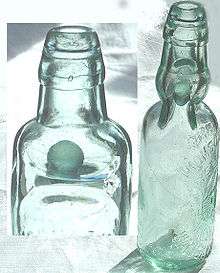
In 1872, British soft drink makers Hiram Codd of Camberwell, London, designed and patented a bottle designed specifically for carbonated drinks. The Codd-neck bottle was designed and manufactured to enclose a marble and a rubber washer/gasket in the neck. The bottles were filled upside down, and pressure of the gas in the bottle forced the marble against the washer, sealing in the carbonation. The bottle was pinched into a special shape, as can be seen in the photo to the left, to provide a chamber into which the marble was pushed to open the bottle. This prevented the marble from blocking the neck as the drink was poured.
Soon after its introduction, the bottle became extremely popular with the soft drink and brewing industries, mainly in Europe, Asia and Australasia, though some alcohol drinkers disdained the use of the bottle. One etymology of the term codswallop originates from beer sold in Codd bottles, though this is generally dismissed as a folk etymology.[4]
The bottles were regularly produced for many decades, but gradually declined in usage. Since children smashed the bottles to retrieve the marbles, they are relatively scarce and have become collector items; particularly in the UK. A cobalt-coloured Codd bottle today fetches hundreds of British pounds at auction. The Codd-neck design is still used for the Japanese soft drink Ramune and in the Indian drink called Banta.[5]
Plastic bottles
The plastic is strain oriented in the stretch blow molding manufacturing process. Plastic bottles are typically used to store liquids such as water, soft drinks, motor oil, cooking oil, medicine, shampoo, milk, and ink. The size ranges from very small sample bottles to very large carboys. The main advantage that plastic bottles have over glass is their superior resistance to breakage, in both production and transportation. But, at the same time, they are non-degraded and cause environmental problems.
Aluminium bottles
An aluminium bottle is a bottle made of aluminium (or aluminum, in American English). In some countries, it is also referred to as a "bottlecan". It is a bottle made entirely of aluminium that holds beer, soft drinks, wine, and other liquids.
Hot water bottles
A hot water bottle is a bottle filled with hot water used to provide warmth. It can be made from various materials, most commonly rubber, but has historically been made from harder materials such as metal, glass, earthenware, or wood.
Gallery
 A PET bottle
A PET bottle- Stone ware jar for carrying water
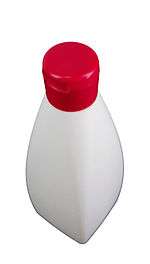 A bioplastic shampoo bottle made of PLA-blend bio-flex
A bioplastic shampoo bottle made of PLA-blend bio-flex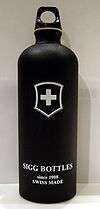 A contemporary metal bottle (Sigg)
A contemporary metal bottle (Sigg)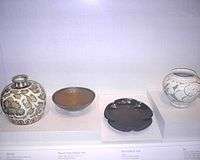 Chinese ding-ware porcelain bottle (far left) with iron-tinted pigment under a transparent colorless glaze, 11th century, Song Dynasty
Chinese ding-ware porcelain bottle (far left) with iron-tinted pigment under a transparent colorless glaze, 11th century, Song Dynasty Normflasche bottle
Normflasche bottle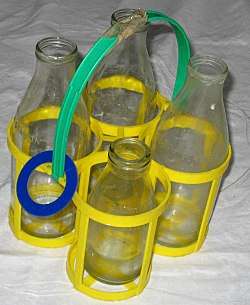 Reusable glass milk bottles
Reusable glass milk bottles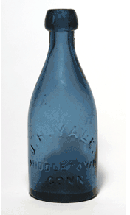 Pontiled soda or beer "blobtop" bottle, circa 1855
Pontiled soda or beer "blobtop" bottle, circa 1855 Bocksbeutel bottle
Bocksbeutel bottle Metal Water Bottles.
Metal Water Bottles.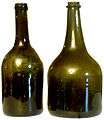 Two bottles for Maas wine, called "thieves", 18th century, at the Gourmet Museum and Library, Hermalle-sous-Huy, Belgium
Two bottles for Maas wine, called "thieves", 18th century, at the Gourmet Museum and Library, Hermalle-sous-Huy, Belgium- A bottle wall of an earthship bathroom
 Bottle, 18th–19th-century Iran. Brooklyn Museum.
Bottle, 18th–19th-century Iran. Brooklyn Museum..jpg)
 Aluminium spray bottle
Aluminium spray bottle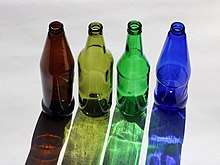 Empty beer bottles of different colors
Empty beer bottles of different colors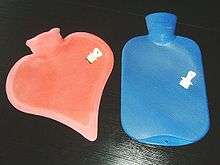 Two modern hot water bottles shown with their stoppers
Two modern hot water bottles shown with their stoppers
Miscellany
Bottles are often recycled according to the SPI recycling code for the material.
See also
- Beer bottle
- Bottle sling
- Bottle wall
- Bottling company
- Bottling (concert abuse)
- Butylka - The largest building in the world in the shape of a bottle
- Carinate
- Glass production
- Helmholtz resonance
- Klein bottle
- List of bottle types, brands and companies
- List of bottling companies
- Reuse of bottles
- Speyer wine bottle
Notes
- ↑ Soroka, W (2008). Glossary of Packaging Terminology. IoPP. p. 21. ISBN 1-930268-27-0.
- ↑ Bottle, Online Etymology Dictionary
- ↑ βοῦττις, Henry George Liddell, Robert Scott, A Greek-English Lexicon, on Perseus
- ↑ UK word origins
- ↑ "Banter about Banta". The Hindu. 19 April 2013. Retrieved 27 May 2018.
References
- Soroka, W, "Fundamentals of Packaging Technology", IoPP, 2002, ISBN 1-930268-25-4
- Yam, K. L., "Encyclopedia of Packaging Technology", John Wiley & Sons, 2009, ISBN 978-0-470-08704-6
| Wikimedia Commons has media related to Bottles. |